|
|
|
CONTACT US
Click Here! |
| This site is best viewed with a screen resolution of 800 X 600 at high colour settings |
|
Flask list
Acacallis-Ancistrochilus Angraecum-Aspasia Barkeria-Broughtonia Bulbophyllum Capanemia-Catasetum Cattleya Cattleyopsis-Cycnoch, Cymbidium-Cyrtorchis Dendrobium-Dossinia Encyclia-Eulophiella Galeandra-Kalopternix Laelia-Lycaste Macodes-Nephalaphyll, Odontogloss,-Oncidium Paphiopedilum-Psychilis Rangaeris-Stenocoryne Tainia-Zygopetalum |
|
Plant list
Acampe-Bulbophyllum Cattleya-Dossinia Encyclia-Promeaea Renanthera-Vanda |

BP SPECIES NEWSLETTER December 2001Jan01 Feb Mar April May June July August September October November
Photos in this issue: Aerides lawrenceae sanderiana (above right), Miltonia moreliana, Paraphalaenopsis serpentilingua. Paraphalaenopsis denevii, Paraphal labukensis, Paraphal laycockii.Do you know any orchid growers who may like to receive this newsletter? Why not forward this email to them now!A b&w printed copy of this Newsletter can be mailed each month if you send 12 Australian stamps or 12 International reply coupons to Burleigh Park Orchid Nursery, 54 Hammond Way, Thuringowa, Australia 4815.Items in this newsletter may be reproduced provided source acknowledged.We commend "Orchids Online Web Design" for the excellent work on our web site and this Newsletter.For information or prices click here or email Steve at steve@orchidsonline.com........A. What's New in flask. Miltonia moreliana. This is the large all plum, dark plum purple Brazilian species, two awarded clones crossed. Grows best in a basket or on a treefern slab with extra water, the flowers are large, richly coloured and spectacular.
Miltonia moreliana. This is the large all plum, dark plum purple Brazilian species, two awarded clones crossed. Grows best in a basket or on a treefern slab with extra water, the flowers are large, richly coloured and spectacular.
Aerides lawrenceae var sanderiana. A very richly coloured form with cream yellow flowers tipped magenta purple. A rampant grower, will need a basket. Photo top of page. Dendrobium primulinum giganteum. A pendulous stem bears, at the nodes, pairs of delicate waxy pink to purple pink flowers with a cream, furry labellum. Very fragrant, deciduous in winter, so ideal for any climate, just dry it out in winter B. What's ready to replate NOW.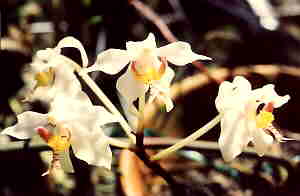 Paraphalaenopsis serpentilingua (right) and Paraphal labukensis. See Culture below.
Paraphalaenopsis serpentilingua (right) and Paraphal labukensis. See Culture below.
Dendrobium punamense is a showy small growing Latourea Dendrobium from New Guinea. The flowers are in clusters, green and white. Best grown in a small pot or basket in a media that will stay damp but not wet. Several seedlings grown together in a small pot will produce an attractive small growing specimen. Dossinia marmorata var Dayii. This is the more reddish leaf form with the red to copper veins. A showy Jewel Orchid, the seedlings develop well from flask in a mixture of spaghnam moss and shredded isolite. Seasonal in growth, it rests in winter, the flask seedlings are now putting up good strong shoots ready for the final replate. Paphiopedilum gratrixianum. A good growing form, the large yellow and brown flowers are very striking. Grows well in a spaghnam mix and plants do well with a little extra sunlight.A cool to intermediate grower, the extra sunlight produces the purplebrown colouring in th leaf bases, making an attractive plant even when not in flower. C. What's new in Plants.Epidendrum difforme.This produces waxy green flowers in apical clusters. A most unusual species, the plant and flowers appear to be made from green wax. Currently growing and flowering in 8cm basket pots in 50/50 spagh/isolite media.Aerides maculosum, with long pendulous spikes of crystalline pink flowers, are in spike in 8cm basket pots in a bark/isolite mix. The flowers are fragrant, sparkling pink to pink purple. A very easy to grow species that requires warm to intermediate conditions and good drainage. It originates from India and it is now very difficult to get orchids from that part of the world. 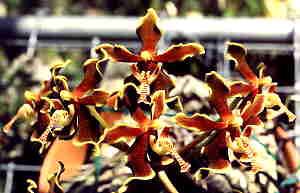 Paraphalaenopsis labukensis (right), laycockii and serpentilingua are growing well on small pieces of cork. A small number of near flowering size plants are available. All listed plants are Nursery raised from seed.
TOP
Paraphalaenopsis labukensis (right), laycockii and serpentilingua are growing well on small pieces of cork. A small number of near flowering size plants are available. All listed plants are Nursery raised from seed.
TOP
D. Culture
|
|
Suppliers of Fine Orchid Literature
|
Grahame & Margaret Muller
Fax: 07 4122 4539 International Fax: + 61 7 4122 4539
P O Box 4192 Tinana, Qld, AUSTRALIA 4650.
Email:gmuller@mary.big.net.au
ORCHIDACEOUS BOOKS is an Australian specialist supplier of orchid literature.
We stock more than 100 new titles with more available at short notice.
We buy and sell pre-owned titles and generally stock in excess of 150 pre-owned titles.
If you are searching for a particular title - New or Pre-owned - email us now for our current catalogue as we may have it in stock or may be able to source it for you.
All stock available for world wide delivery
H. A special note on flasking orchids.
Due to the need for a filtered air vent on flasks to allow exchange of gasses, a reliable air filter medium is needed.Non absorbant cotton wool allows gas exchange but does not absorb moisture. Thus the air filter will stay dry and prevent the growth of fungus thru the filter, a common problem with ordinary cotton wool which gets wet, goes mouldy and allows the mould to grow thru the filter to contaminate the flask.
Non Absorbant Cottonwool NOW AVAILABLE in 375 gram rolls, contact us NOW.
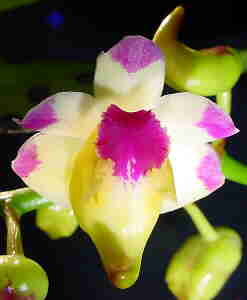
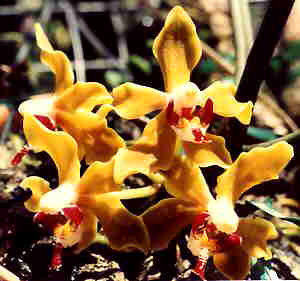 The genus Paraphalaenopsis consists of 4 terete leafed plants from Borneo. They are inhabitants of a tropical high rainfall climate and require appropriate conditions in the orchid house.
The genus Paraphalaenopsis consists of 4 terete leafed plants from Borneo. They are inhabitants of a tropical high rainfall climate and require appropriate conditions in the orchid house.
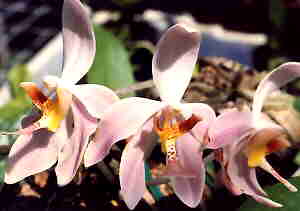 Paraphalaenopsis laycockii (left), with the largest flowers, is a soft pink with a yellow and red marked labellum. These flowers, usually several to the spike, are up to 8cm or more long.
Paraphalaenopsis laycockii (left), with the largest flowers, is a soft pink with a yellow and red marked labellum. These flowers, usually several to the spike, are up to 8cm or more long.